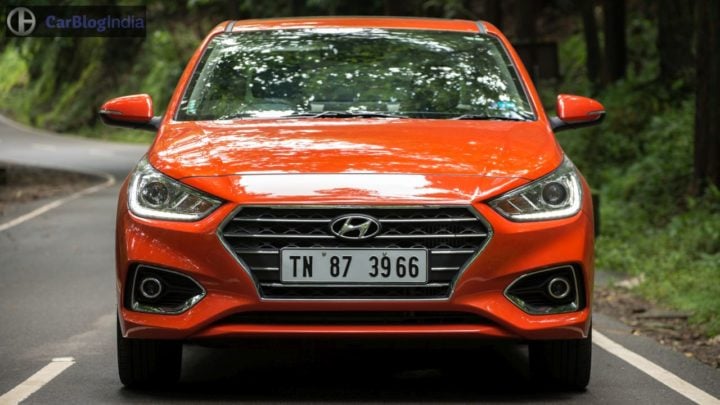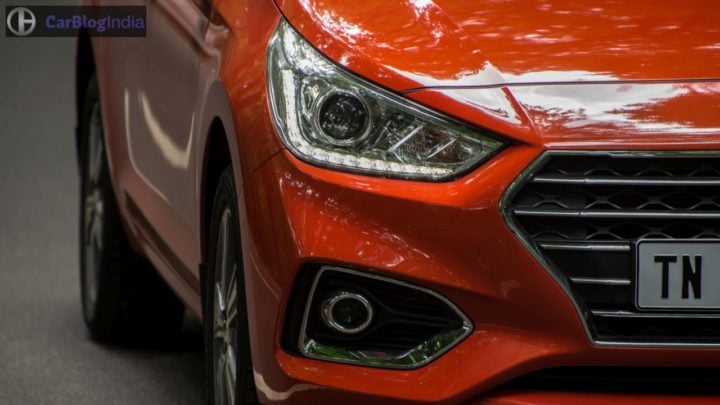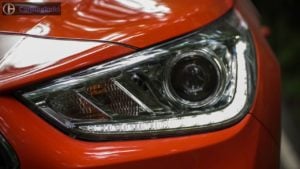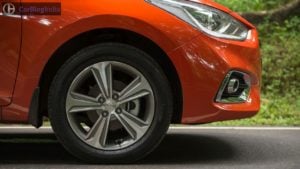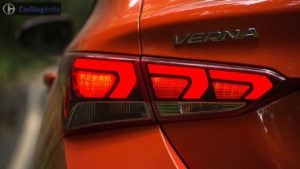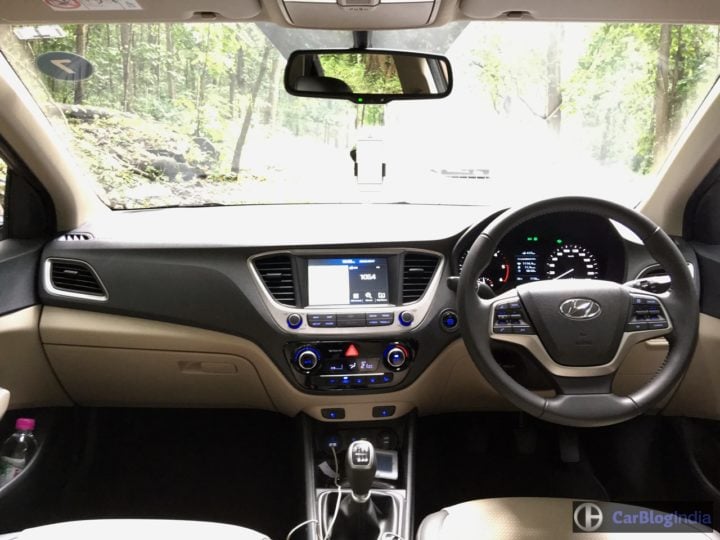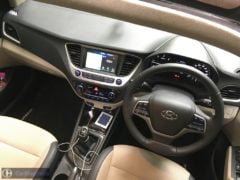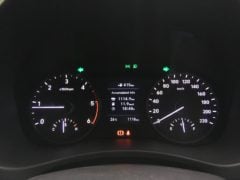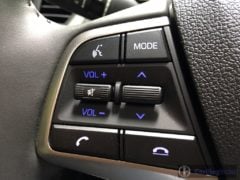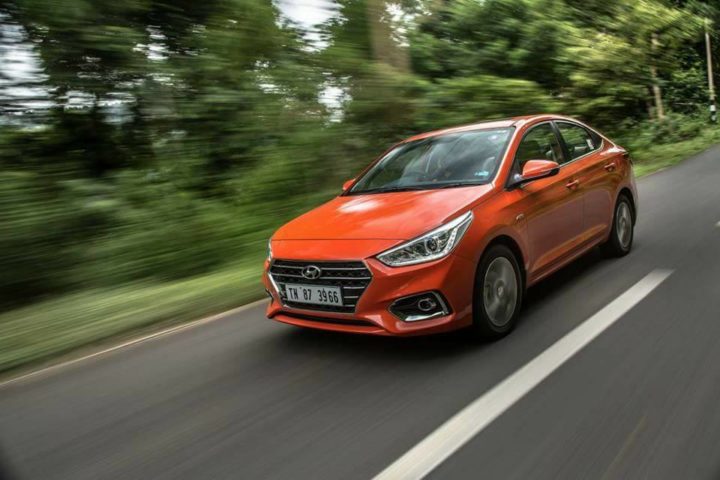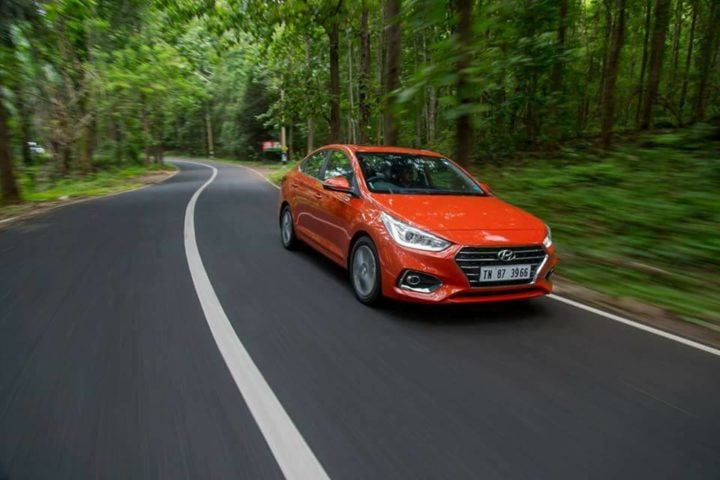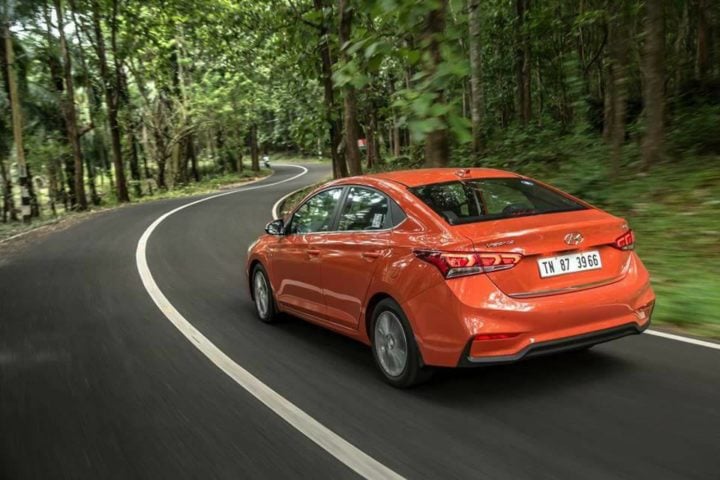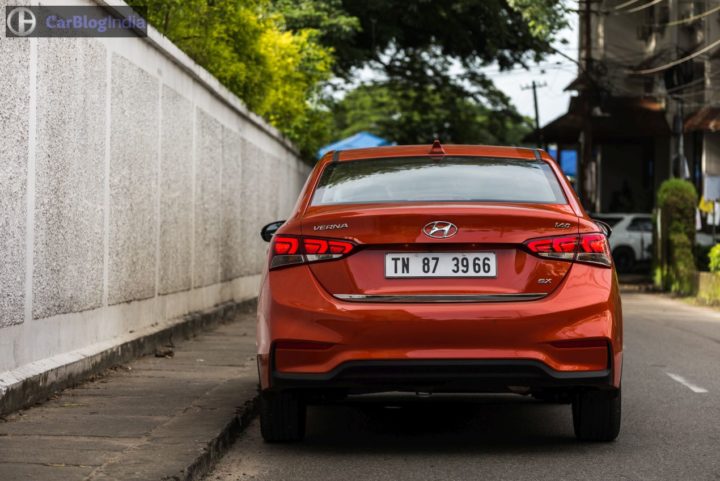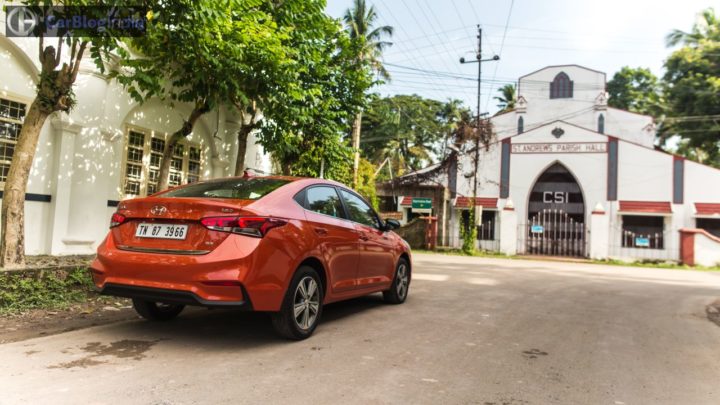New 2017 Hyundai Verna Review – Prologue
The Verna nameplate made it to India in the second-half of 2006. Launched alongside the Accent, the first-ever Verna for India was nothing but the third-gen Accent and here, in our country, the car found itself positioned half a segment higher than its predecessor. Of course, the third-gen Accent, nay, the Verna went on to impress many with its powerful motors, a long list of features, good ride quality and a fairly attractive price tag. While Hyundai India was seen discontinuing the Accent in the years to come, the Verna nameplate soldiered on with an all-new, fourth generation model. Dubbed as the Fluidic Verna, the Mk4 Verna found many takers owing to its really flamboyant design, some first-in-class features, a comfortable cabin, and a set of powerful engines. The Fluidic Verna did fairly well on the sales charts, with the Korean car even managing to outsell the then invincible Honda City over a short period of time. The competition was, however, rather quick to catch up and in recent years, we saw the likes of Maruti Ciaz and Honda City managing to steal all the limelight away from this Korean combatant. Certainly not the one to give up, HMIL has now launched the all-new, fifth-generation Accent, which becomes the third-generation Verna for India. Our new 2017 Hyundai Verna review here takes you through all the finer details of this new model.
Test Drive Review Video –
Also See – Upcoming Hyundai Cars
New 2017 Hyundai Verna Review – Video
Chapter 1: Evolutionary with the right dose of flamboyance
While the last-generation Verna was nothing short of a revolution over its predecessor, the latest version boasts a design that builds up on the aesthetics of the outgoing car. We have always appreciated the way Hyundai’s design language has evolved over the last decade or so. From simple, and I daresay, even a tad boring design of the first Verna for India to the utterly flamboyant and youthful design of the latest model – the Korean auto giant has really come a long way in a relatively short time-span.
The new Hyundai Verna 2017’s design is based on the carmaker’s Fluidic Sculpture 2.0 theme. In essence, the new design direction builds up on the version 1.0. Well, the transition is more evolutionary than revolutionary. As a result, while the earlier Verna was all about bold creases, taut surfaces and hence, the resulting loudness, the new car comes across as a more handsome model which, whilst retaining the crisp lines and the rather dynamic surfaces, manages to come across as significantly classier. We are pretty sure the design of the new car will appeal to a much wider audience. While some of you might argue that the design of the last generation car was ahead of its time and hence, a bit too loud for some, we would like to add that the new model looks at least as athletic whilst offering a new-age look.
The front-end of the car is characterized by Hyundai’s ‘Cascading Effect’ front grill, which goes on to give this car a nose that’s similar to that of the latest Elantra. The very stylish swept-back headlamps sport LED DRLs and bestow onto the car’s face a touch of sportiness. The LED DRLs, together with the chrome accents for the foglamp-enclosures, lend a touch of sophistication. The side-profile is where things get highly reminiscent of the earlier model. True, it’s definitely not like the design has been carried over from the predecessor, but it’s just that the car’s sides lack the newness that its front- and rear-end have on offer. The rear-end is mostly a reflection of the front. The wrap-around taillamps remind you of the latest Elantra, while the crisp lines along with clutter-free surfaces make the car look edgy-yet-mature.
Chapter 2: Modern and Loaded to its brim
Honestly, the interior of the new Verna leaves us with rather mixed emotions. Well, there are definitely a lot of likeable things about the cabin. For starters, the interior gets a really long list of features. Among the important highlights is a modern infotainment unit, an electric sunroof and ventilated seats. The piece-de-resistance, however, is the Auto Link app that syncs your smartphone with the car’s ECM to offer you data on everything ranging from the travel time of your journey to the engine load and the no. of acceleration bursts. The infotainment unit offers support for Android Auto and Apple CarPlay. In its top-spec, the Verna offers six airbags, which is something that is highly applaud-able.
Interior setups of most Hyundai cars are quite well-laid out and have a sense of quality to them. The same is the case here. Well, a solidly-built, well laid-out interior has its own charm, but where this car leaves us disappointed is with the slight lack of enough leg-space at the rear. Well, we never expected the car to offer Ciaz-like spaciousness, but the increased wheelbase on the new car simply fails to free up more space for the rear passengers. Even the rear bench-seat, which is sufficiently wide to accommodate two adults and a kid, lacks under-thigh support.
Chapter 3: Powerful yet Refined
The Mk5 Verna comes offers two engines – a 1.6-litre VTVT Petrol and a 1.6-litre CRDi Diesel. No, there are no 1.4-litre engines this time around, at least not yet. Transmission options for both the motors include a 6-speed Manual and a 6-Speed Automatic (torque-converter) gearboxes. The previous generations of the Verna impressed us with their really powerful engines and the Mk5 continues the tradition of offering a few extra ponies over most rivals. Hyundai India claims the engines for their newest member are the most power in their class. Well, that’s partly true. While the 126 BHP Diesel engine is actually the mightiest oil-burner in the C2-segment, the 121 BHP Petrol falls short of the 125 PS 1.4-litre turbo unit of the Linea 125S. Let’s just say that the Petrol Verna is the most powerful among the more popular models of its class. While the Petrol engine churns out a max. power of 154 Nm, the oil burner outputs 265 Nm.
These engines are essentially re-tuned versions of the 1.6-litre units offered on the outgoing car. The difference in the engine specifications isn’t too significant, at least not on the paper. But out on the road, the engine updates go on to offer a considerably enhanced performance. The petrol engine gets a bit more refined and even feels a tad peppier. There’s enough grunt to effortlessly pick speed from standstill with the second cog engaged. The torque-spread is pretty much linear, with the car exhibiting enough gusto throughout the rev-range. The Diesel motor is our pick of the two. True, it misses out on the high refinement of its petrol sibling, but more than makes up for it with the abundance of torque it has on offer, Even the NVH levels are lower, with the oil burner getting really vocal only when shown the stick. The turbo lag isn’t too evident, but the engine really comes to life around 1,800 RPM. It’s a pretty rev-happy unit for a Diesel motor.
We drove the manual transmission variants of both the cars. For the petrol model, the gear ratios are well spaced and the transmission offers a smooth and precise gear-shifting action.We sampled both the engine variants on busy streets of Kochi, an expressway and even a winding road. The engines impressed us with their high performance levels and refinement. As expected, the Petrol motor gets a bit thirsty when driven with a heavy foot, but the Diesel motor has impressed us with its strong performance and high frugality in most driving conditions.
Chapter 4: A Lot More Confident
The new Verna is underpinned by the Elantra’s K2 platform. To put it in a nutshell, the new underpinnings have done a lot of good to this car. Believe you me, the Verna is now far more composed in the corners. The steering isn’t lifeless and the body roll is conspicuous by its absence. All this leads to much more confidence while apex hunting and a definite sense of engagement with the car.
The suspension still is on the softer side, but the ride never gets too bouncy over broken surfaces and road irregularities. The car stays planted even at very high speeds and the brakes have enough bite to haul down this car from the aforementioned velocities. Hyundai claims the braking distances are now considerably shorter than on the previous car and we really have no reason to doubt the Korean auto giant. Other than having a stronger bite, the brakes also offer a much more linear stopping force.
Epilogue
The new Verna has a lot going for it, really. Okay, the aesthetics don’t see a revolutionary change, but we are really happy with the way the car looks more matured while still offering the flamboyance that the earlier car did. The interior also feels far more premium and the really long list of features simply sets the cabin apart. The engines are not only really powerful but are also sufficiently frugal. With a price tag of Rs 12.65 lakh for the top-end Diesel automatic model, the new Verna is considerably cheaper, yet more feature laden and more powerful, than its most immediate Japanese adversary – the Honda City. Also, with a starting price of Rs 7.99 lakh, the new car is also not much costlier than the Maruti Ciaz.
The biggest chink in the armour, however, comes from the slightly cramped rear. With the Maruti Ciaz having set the benchmark in cabin space, the new Verna is likely to have a tough time impressing the chauffeur-driven. Also, while more power is always welcome, we are still not sure if the car buying lot would prefer the extra grunt over the stellar mileage the competition offers. That said, the new Verna is really a great improvement over the earlier model and should impress those who’ve been looking for a well rounded car that offers a comfortable cabin, many features, powerful engines, and is at least sufficiently frugal.
So, what do you think of our new 2017 Hyundai Verna review? Do you plan to put your money on the new car? Has our new 2017 Hyundai Verna review here helped you with your purchase decision? You can share all your views by penning them down as comments below.
New 2017 Hyundai Verna Review – Prices
| Hyundai Verna Variant | Ex-showroom Delhi Price |
| Hyundai Verna 1.6 Petrol E Manual | INR 799,900 |
| Hyundai Verna 1.6 Petrol EX Manual | INR 906,900 |
| Hyundai Verna 1.6 Petrol EX Automatic | INR 1,022,900 |
| Hyundai Verna 1.6 Petrol SX Manual | INR 949,900 |
| Hyundai Verna 1.6 Petrol SX(O) Manual | INR 1,108,900 |
| Hyundai Verna 1.6 Petrol SX(O) Automatic | INR 1,223,900 |
| Hyundai Verna 1.6 Diesel E Manual | INR 919,900 |
| Hyundai Verna 1.6 Diesel EX Manual | INR 999,900 |
| Hyundai Verna 1.6 Diesel EX Automatic | INR 1,139,900 |
| Hyundai Verna 1.6 Diesel SX Manual | INR 1,111,900 |
| Hyundai Verna 1.6 Diesel SX+ Automatic | INR 1,261,900 |
| Hyundai Verna 1.6 Diesel SX(O) Manual | INR 1,239,900 |
New 2017 Hyundai Verna Review – Specifications
| Engine displacement and type | 1.6 litre Dual VTVT petrol | 1.6 CRDi, Turbocharged four-cylinder |
| Power | 121 BHP | 126 BHP |
| Torque | 154 Nm | 265 Nm |
| Transmission | 6-speed manual/6-speed automatic | 6-speed manual/6-speed automatic |
New 2017 Hyundai Verna Review – Dimensions
| Length | 4,385 mm |
| Width | 1,729 mm |
| Height | 1,450 mm |
| Wheelbase | 2,580 mm |
| Ground Clearance | 170 mm |
New 2017 Hyundai Verna Review – Features
2017 Hyundai Verna E Features
- ABS with EBD
- Dual front airbags
- Central Locking
- ISOFIX child seat anchors
- Beige-Black interior
- Fabric seat upholstery
- Rear center armrest with cup holder
- Halogen headlamps
- Full wheel covers
2017 Hyundai Verna EX Features – All features of the E trim along with-
- Automatic headlamps
- Reverse Parking Camera
- Follow-me home lights
- Impact sensing auto door lock/unlock
- Cruise control
- Keyless entry
- Cooled glove compartment
- 5.0-inch touchscreen audio system
2017 Hyundai Verna S Features– All features of the EX trim along with-
- Height adjustable front seat belts
- 7.0-inch infotainment system
- Mirror Link
- Apple CarPlay
- Android Auto
- Leather wrapped steering
- Gear knob
- Projector headlamps
- LED Daytime Running Lamps (DRLs)
- LED taillamps
- 16-inch diamond cut alloy wheels
- Shark-fin roof antenna
- Electric sunroof
2017 Hyundai Verna SX Features– All features of S trim along with-
- 6 airbags
- Auto-dimming interior rear view mirror
- Smart key
- Chrome-plated door handles
- Adjustable light for instrument console
- Smart trunk
- Adjustable rear seat headrests
- Push button start/stop
- Leather seat upholstery
- Auto link (Connected Car Technology)
- Ventilated seats
- Rear curtain
Stay tuned for more test drive reports like the one we have in our New 2017 Hyundai Verna Review here.


